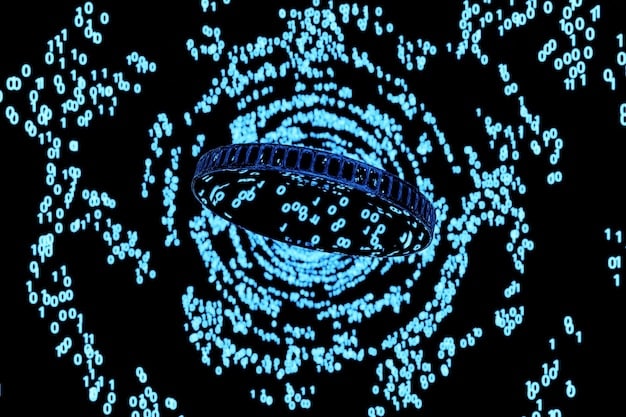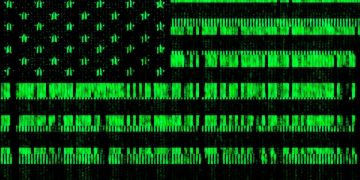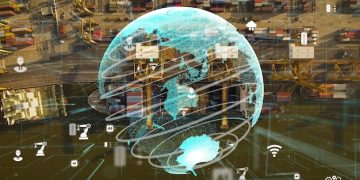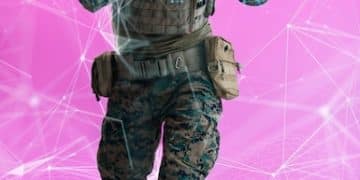Quantum Computing & Cryptography: Protecting Military Comms

Quantum computing’s potential to break current encryption methods poses a significant threat to military communications, necessitating the development and implementation of quantum-resistant cryptography to safeguard sensitive information.
The landscape of military communications is on the brink of a monumental shift, driven by the relentless advancement of technology. The emergence of quantum computing and cryptography: securing military communications against future threats is no longer a distant hypothetical, but a rapidly approaching reality with profound implications for national security.
Understanding Quantum Computing’s Threat to Cryptography
Quantum computing, a revolutionary paradigm in computation, leverages the principles of quantum mechanics to solve complex problems far beyond the capabilities of classical computers. While offering immense potential across various fields, its ability to break widely used encryption algorithms poses a significant risk to cybersecurity, particularly military communications.
The Power of Quantum Computing
Quantum computers differ fundamentally from classical computers. They utilize qubits, which can exist in multiple states simultaneously due to superposition and entanglement, allowing them to perform calculations in parallel, exponentially increasing their processing power.
Shor’s Algorithm and Cryptographic Vulnerabilities
Peter Shor’s algorithm, developed in 1994, demonstrates the potential of quantum computers to efficiently factor large numbers, a task that is computationally infeasible for classical computers. This poses a direct threat to algorithms like RSA and ECC, which underpin much of modern encryption. If a sufficiently powerful quantum computer were to exist, it could break these algorithms, compromising secure communications.

- Increased Processing Power: Quantum computers have the potential to solve complex cryptographic problems much faster than classical computers.
- Breaking Encryption: Algorithms like Shor’s algorithm threaten the security of current encryption methods.
- Vulnerability of Military Comms: Secure military communications can be intercepted and decrypted by malicious actors.
Quantum computing represents a genuine threat to modern cryptography, with the potential to render current encryption methods obsolete. This necessitates a proactive approach to developing and implementing quantum-resistant cryptographic solutions, particularly in sensitive areas such as military communications.
The Imperative of Quantum-Resistant Cryptography
As quantum computing capabilities continue to advance, the development and implementation of quantum-resistant cryptography, also known as post-quantum cryptography (PQC), becomes increasingly crucial for safeguarding military communications. PQC algorithms are designed to withstand attacks from both classical and quantum computers.
What is Post-Quantum Cryptography?
Post-quantum cryptography (PQC) refers to cryptographic algorithms that are believed to be secure against attacks by both classical and quantum computers. These algorithms are designed to replace existing cryptographic systems that are vulnerable to quantum attacks.
NIST’s PQC Standardization Process
The National Institute of Standards and Technology (NIST) is leading a global effort to standardize PQC algorithms. NIST has been evaluating candidate algorithms through a multi-year process, aiming to select a set of algorithms suitable for widespread adoption. This standardization effort is vital for ensuring interoperability and security in the quantum era.

Different Approaches to Quantum-Resistant Cryptography
Several approaches are being explored in the field of PQC, each with its own strengths and weaknesses. Some of the most promising include:
- Lattice-Based Cryptography: Algorithms based on the hardness of lattice problems.
- Code-Based Cryptography: Algorithms based on error-correcting codes.
- Multivariate Cryptography: Algorithms based on the difficulty of solving multivariate polynomial equations.
- Hash-Based Cryptography: Algorithms based on the security of cryptographic hash functions.
- Supersingular Isogeny Diffie-Hellman (SIDH): A key exchange protocol based on isogenies between supersingular elliptic curves.
Quantum-resistant cryptography is essential for maintaining the security of military communications in the face of advancing quantum computing capabilities. By developing and implementing PQC algorithms, military organizations can protect sensitive information from potential quantum attacks.
Securing Military Communications: Challenges and Strategies
Securing military communications against future threats requires a comprehensive strategy that addresses the unique challenges posed by quantum computing. This includes assessing vulnerabilities, implementing PQC solutions, and adapting security protocols.
Assessing Vulnerabilities in Existing Systems
The first step in securing military communications is to identify and assess vulnerabilities in existing cryptographic systems. This involves analyzing the types of encryption algorithms currently in use and determining their susceptibility to quantum attacks.
Implementing PQC Solutions in Military Infrastructure
Implementing PQC solutions in military infrastructure requires careful planning and execution. This includes selecting appropriate PQC algorithms, deploying them across communication networks, and ensuring that they are properly integrated with existing systems.
Adapting Security Protocols and Training Personnel
Adapting security protocols and training personnel are essential for ensuring the effective implementation of PQC solutions. This involves updating security policies, training personnel on the use of new cryptographic tools and techniques, and conducting regular security audits.
Securing military communications in the quantum era requires a proactive and multifaceted approach. By assessing vulnerabilities, implementing PQC solutions, and adapting security protocols, military organizations can mitigate the risks posed by quantum computing.
The Role of Quantum Key Distribution (QKD)
Quantum Key Distribution (QKD) offers an alternative approach to securing military communications by leveraging the principles of quantum mechanics to generate and distribute encryption keys. QKD systems use single photons to transmit cryptographic keys, providing a level of security that is impossible to achieve with classical methods.
How QKD Works
QKD relies on the principles of quantum mechanics to ensure secure key exchange. Any attempt to intercept the photons during transmission will inevitably disturb their quantum state, alerting the legitimate parties to the presence of an eavesdropper.
Advantages and Limitations of QKD
QKD offers several advantages over classical key distribution methods, including its inherent security and its ability to detect eavesdropping attempts. However, QKD also has limitations, such as its limited range and its dependence on specialized hardware.
QKD in Military Applications
Despite its limitations, QKD has the potential to play a significant role in securing military communications. QKD systems could be used to protect highly sensitive information, such as classified intelligence and command-and-control data.
Quantum Key Distribution offers a compelling approach to securing military communications, complementing PQC solutions. While challenges exist, ongoing advancements in QKD technology promise to expand its range and practical applicability for protecting sensitive data.
Collaboration and International Standards
Addressing the challenges of quantum computing and cryptography requires a collaborative effort involving governments, industry, and academia. International standards play a crucial role in ensuring interoperability and security in the quantum era.
The Importance of Collaboration
Collaboration is essential for accelerating the development and deployment of PQC solutions. By sharing knowledge, resources, and expertise, governments, industry, and academia can work together to address the challenges posed by quantum computing.
Developing International Standards for PQC
International standards are needed to ensure that PQC algorithms are implemented consistently and securely across different systems and networks. Standards organizations, such as the International Organization for Standardization (ISO) and the Internet Engineering Task Force (IETF), are working to develop standards for PQC.
Sharing Information and Best Practices
Sharing information and best practices is crucial for raising awareness of the risks posed by quantum computing and for promoting the adoption of PQC solutions. Governments, industry, and academia should actively share information and best practices to ensure that all stakeholders are aware of the challenges and opportunities presented by quantum computing.
Collaboration and international standards are essential for ensuring a secure and interoperable quantum future. By working together, governments, industry, and academia can address the challenges posed by quantum computing and protect sensitive information from future threats.
Future Trends and Emerging Technologies
The field of quantum computing and cryptography is constantly evolving, with new technologies and approaches emerging on the horizon. Staying abreast of these developments is crucial for maintaining a strong security posture.
Advancements in Quantum Computing Hardware
Advancements in quantum computing hardware are driving the development of more powerful and reliable quantum computers. As quantum computers become more capable, the threat to existing cryptographic systems will increase.
New Cryptographic Algorithms and Techniques
Researchers are constantly developing new cryptographic algorithms and techniques that are designed to be resistant to quantum attacks. These algorithms offer the potential to enhance the security of military communications and other sensitive systems.
Quantum-Safe Hybrid Systems
Quantum-safe hybrid systems combine PQC algorithms with classical cryptographic methods to provide an additional layer of security. These hybrid systems offer a practical approach to transitioning to a quantum-resistant future.
The future of quantum computing and cryptography is uncertain, but it is clear that these technologies will continue to evolve rapidly. By staying informed about the latest developments and investing in research and development, military organizations can prepare for the challenges and opportunities that lie ahead.
| Key Point | Brief Description |
|---|---|
| 🛡️ Quantum Threat | Quantum computers can break current encryption. |
| 🔒 PQC | Post-quantum cryptography resists quantum attacks. |
| 🔑 QKD | Quantum Key Distribution ensures secure key exchange. |
| 🤝 Collaboration | Global cooperation is vital for PQC development. |
FAQ
▼
Quantum computing is a type of computation that uses quantum mechanics principles to solve problems too complex for classical computers, leveraging phenomena like superposition and entanglement.
▼
Certain quantum algorithms, such as Shor’s algorithm, can efficiently break widely used encryption methods like RSA and ECC, which are the foundation of current cybersecurity.
▼
PQC refers to cryptographic algorithms designed to remain secure against attacks from both classical and quantum computers, aiming to replace vulnerable existing systems.
▼
QKD uses the laws of quantum mechanics to distribute encryption keys securely. Any attempt to intercept the key alters its state, immediately alerting the parties involved.
▼
Implementing PQC involves challenges like computational overhead, integration complexity with existing systems, and the need for standardization to ensure interoperability and security.
Conclusion
The convergence of quantum computing and cryptography presents both a formidable challenge and a unique opportunity for the future of military communications. As quantum capabilities advance, proactive investment in quantum-resistant solutions, collaborative efforts, and adaptive security protocols are essential for safeguarding sensitive information and maintaining strategic advantage in an increasingly complex digital landscape.





